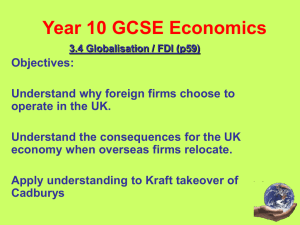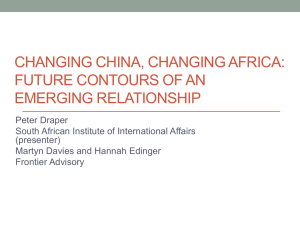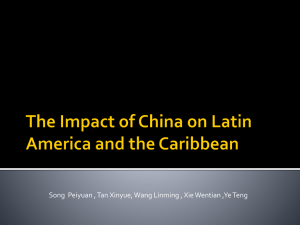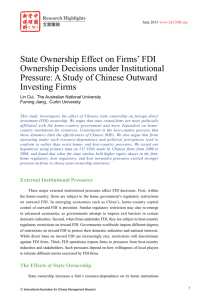Foreign Direct Investment Links between South Africa and
advertisement
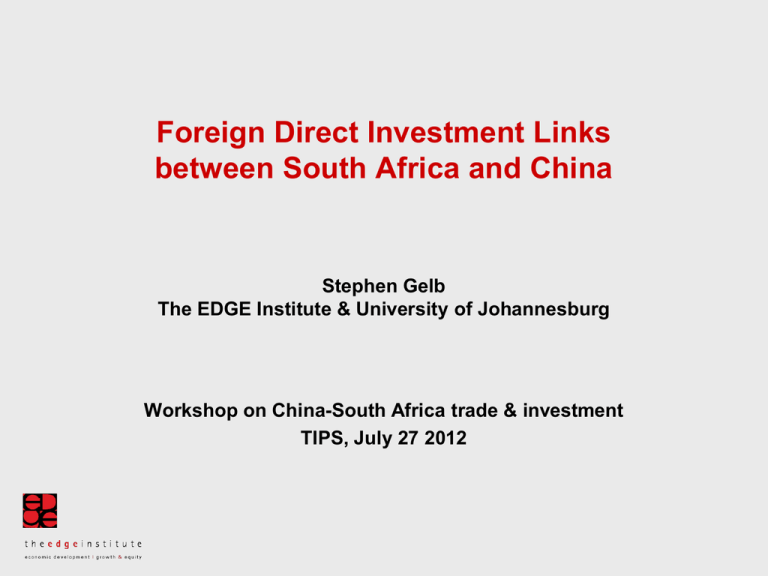
Foreign Direct Investment Links between South Africa and China Stephen Gelb The EDGE Institute & University of Johannesburg Workshop on China-South Africa trade & investment TIPS, July 27 2012 Introduction & Methodology China was SA’s top trade partner in 2009 ($14.2 bn) & 2010 ($19.3 bn), China surplus $3.45 bn Very rapid trade growth over past 15 years, mixed impact on SA Other BRICS: India – ranked 6th, total trade $5.8 bn 2010 (2009: $4.0 bn), SA surplus $0.2 bn Brazil – total trade $2.05 bn Russia – total trade $0.77 bn But little attention to the scale & significance of FDI links, despite much media discussion of Chinese FDI in Africa Look at FDI links in both directions – China into SA and SA into China Overall size and shape of the FDI relationship Impact of FDI on growth & development – policy & analytical issues Use two in-depth sector case studies Chinese brown goods manufacturers in SA (TV and other electronic appliances) Financial services firms in both countries FDI between China & SA: Official aggregate data Data from both countries is contradictory & inconsistent Official data on FDI stocks & flows Other BRICS: India: FDI in SA $2.3 bn, FDI in India $0.93 bn Brazil: FDI in SA $0.2 bn, FDI in Brazil $0.62 bn Russia: FDI in SA $5.4 bn, FDI in Russia $0.17 bn China-SA FDI stocks appear to have grown very rapidly since 2007 & important for both countries China has a significant share of South African FDI stocks for both inward and outward FDI – 4.2% for IFDI & 6.3% for OFDI (SARB data) South Africa has a significant share of Chinese outward FDI stocks – 8.2% (adjusted MOFCOM data) But official data is unreliable: Inconsistencies: between 2 countries, over time, stocks vs flows 3rd country routing And not very useful: Growth almost all from 2 holdings: ICBC in Standard Bank, Naspers in Tencent No sectoral or flow breakdown by country FDI between China & SA: Firm-level data The EDGE Institute FDI Database Chinese firms in SA 47 present 19 withdrawals 12 possible entrants Of 47 present: 25 SOEs, 13 private, 9 uncertain SA firms in China 32 present 7 withdrawals 9 possible entrants Comparison with India: 93 Indian companies present in SA 2 withdrawals 36 possible entrants to SA 45 South African companies in India 3 withdrawals Sectoral distribution: Chinese firms in SA N = 47 F&B services 13% Consumer services 9% IT/Media Mining 2% 13% Consumer goods 4% Materials 8% Electronic 11% Infrastructure & construction 23% Auto Other machinery 11% 6% Source: EDGE Institute FDI database Sectoral distribution: SA Firms in China N = 32 IT/Media 6% Mining 23% F&B services 17% Consumer services 3% Infrastructure & construction 23% Consumer goods 8% Materials 9% Other machinery 11% Source: EDGE Institute FDI database Electronic 0% Auto 0% Date of Entry (% of firms) China in SA: N = 57 SA in China: N = 38 60 50 40 30 20 10 0 < 1994 1995-99 2000-5 Source: EDGE Institute FDI database Note: Number of firms includes withdrawals >2006 Mode of entry (% of firms) China in SA: N = 57 SA in China: N = 38 70 60 50 40 30 20 10 0 GF JV PA Source: EDGE Institute FDI database Note: Number of firms includes withdrawals FA Assessment Very small number of entries in either direction Linkages are not ‘dense’ – firms thinly spread across many sectors Linkages are not ‘pivotal’ – firms not dominant in any significant sector Many ‘early’ entries on both sides – SA/China amongst the first international destinations of investing companies But also many withdrawals – failed entries – on both sides Entries too small Poor acquisitions Companies over-extended internationally Small market size in SA (Chinese autos: temporary withdrawal?) Most successful Chinese firms have been large SOEs, both market- and resource-seeking Most successful SA firms have been ‘national champions’ (including ‘emigres’) Case study I - Chinese brown goods manufacturers in SA 5 producers in SA - 3 are Chinese Questions: Why did Chinese firms invest in apparently declining manufacturing subsector in SA? What are Chinese firms’ ‘O’ advantages? How do they invest profitably? Should SA be encouraging more Chinese (or other Asian) firms to invest in SA manufacturing to enhance job-creation, skills transfer & manufacturing exports? All three investors are major electronics groups in China, and entered SA very early in their own internationalisation which was response to intense competition in Chinese TV manufacturing as plan shifted to market Chinese firms have a key ‘O’ (ownership) advantage – ability to import own CRTs & other key components They entered SA due to its strong market potential in early 1990s Potential has not been fulfilled – market growth, but supplied by imports • Limited competition, small market with few scale economies, unpredictable policies Case study I – Brown goods (continued) Domestic firms have withdrawn from own production into contract production & importing But Chinese firms have been profitable and expanded & diversified in SA Operate at low end of TV market & moved into washing machines, stoves Collectively supply almost 60% of local TV set output, 25% of domestic market Now also importing higher-end home electronics appliances and establishing brands in market Limited ‘dynamic’ gains or spillovers transfer of technology but benefits nonetheless higher consumer welfare, stable employment Demonstration of potential for durable investment in manufacturing in SA providing modest but stable profitability Manufacturing ‘business model’ – low margins, mass market products Low overheads Access to low-cost production in home economy Case study II – Financial services in China & SA Extensive presence of financial institutions from each country in the other’s market 4 major Chinese banks in SA, entered ‘early’ in internationalisation 3 of 4 major SA banks in Chin, and other SA financial services companies Several alliances - ICBC/Standard, CCB/First Rand, Discovery/Ping An, OM/BSAM, also BoC/Ecobank/Nedbank Questions: Why the significant market presence in both directions? Why the early entry? Why the predominance of alliances? Both countries have strong financial sectors but with very different histories, so financial services firms have different but complementary capabilities SA: long history of foreign engagement, complex corporate/project financing, retail product innovation for middle class Broad capabilities and skills, but small market size limiting capital base & international network growth China: very large but shallow domestic market (corporate & retail), state backing (& control) of financial institutions Very strong capital base, but narrow product range & borrowers’ soft budget constraints have limited capability development Case study II – Financial services in China & SA (continued) Reasons for market presence & early entry vary between 2 countries For SA banks: market-seeking - relatively low entry cost for banks For Chinese banks: market-seeking (trade & immigrants) maybe less important than to support learning (part of banking reform) Early entries had limited impact in host (wholesale) markets Limited scope of ‘O’ advantages is characteristic of ‘South’ firms – difficult to succeed internationally as stand-alone operators Alliances are more recent – based on complementary strengths & potential mutual benefits – more effective market access & expanded networks (Including China/Africa trade), new products & capabilities Explicit choice of other ‘South’ firms as alliance partners Perception that operating environment & risk in EMs is distinctive from developed economies - familiarity is itself an ‘O’ advantage ‘South’ firms have more favourable view of risk/return trade-off in Ems Conclusions China is SA’s major trading partner but FDI relationship is less well developed Official data reflects large value and fast growth since 2007 But small number of firms & relationship is not ‘dense’ – firms spread across many industries, limiting impact Qualified support for view that ‘South-South’ investors are more willing to enter than ‘North-South’ & bring greater benefits to host economy Very early entry by many firms But high failure rates suggest poor risk assessment & premature internationalisation are common Benefits from ‘South-South’ FDI need to take account of specifics of investors’ advantages and of their performance Policies: Better official data – more accurate financial values & firm-level data More focus on investment relationship with China (in addition to trade) SA needs more Chinese (& Asian) inward FDI, especially in labourintensive activities (with appropriate trade policy support) SA needs to promote OFDI, especially by ‘national champions’, with mechanisms to facilitate home country gains Both governments should encourage & facilitate co-operation between SA & Chinese firms, in both economies & in third markets The End For more information: sgelb@the-edge.org.za


